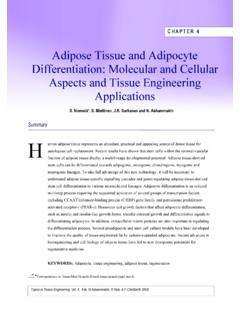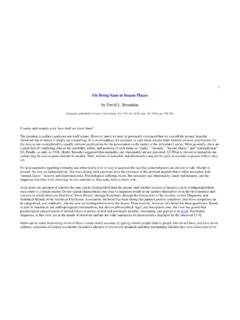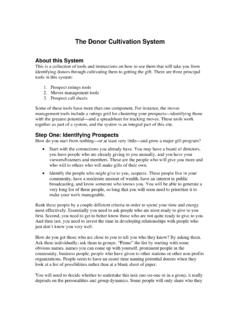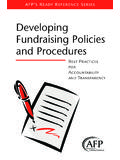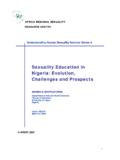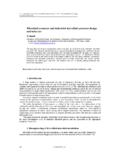Transcription of Design of Bioreactors for Cardiovascular Applications
1 E. Lyons and A. Pandit* Summary S ystems are being developed in the field of reparative medicine to generate cell and tissue-based constructs. Currently available substitutes for failing cardiac tissue have serious limitations. Mechanical heart valves provide effective structural durability and mechanical function, but they are associated with a substantial risk of thromboembolism, thus requiring lifelong anticoagulation. Currently used biological heart valves are known to have superior hemodynamics, but durability is limited. Autografts, allografts and xenografts, which are used as vascular grafts in the surgical treatment of atherosclerosis, have seen limited success, with the vessels failing due to dimensional restrictions, mechanical property mismatch and disjunction at the anastomoses.
2 Synthetic vascular grafts implanted as medium diameter vessel replacements exhibit an acute loss of patency within several months after implantation primarily due to thrombosis. The common trend and major drawback of these cardiac prostheses is that they are composed of foreign body material without the ability to grow, to remodel or to repair. The field of tissue engineering may be the solution to the problem as it offers the possibility of developing a biological substitute material in vitro with the inherent mechanical and morphological properties required in vivo. A major challenge is to Design an in vitro system that produces these clinically effective Cardiovascular tissue-based constructs.
3 Such a system, that attempts to simulate a physiological environment for the creating and preconditioning of cells and Design of Bioreactors for Cardiovascular Applications CHAPTER 7 VII Bioreactors E-book Topics in Tissue Engineering, Volume 2, 2005. Eds. N. Ashammakhi & Reis 2005 *Correspondence to: A. Pandit, Department of Mechanical and Biomedical Engineering, National Centre for Biomedical Engineering Science, National University of Ireland, Galway, Ireland. E-mail: tissues in vitro, is known as a bioreactor . This chapter outlines the requirements and current designs of Bioreactors for the tissue engineering of Cardiovascular constructs, such as heart valve and vascular grafts.
4 Keywords: bioreactor , Cardiovascular , tissue engineering, heart valve, vascular grafts, cell culture Lyons and A. Pandit Design of Bioreactors for Cardiovascular Applications VII Bioreactors 2 Topics in Tissue Engineering 2005, Volume 2. Eds. N. Ashammakhi & Reis 2005 Introduction Current in vitro and in vivo studies have shown limited regeneration properties of the heart in adult mammals (1-3). The functional deficits caused by heart failure can only be partly ameliorated by transplantation due to shortages of donor tissues (4).
5 These limitations have fuelled research in the areas of cardiac tissue and organ replacement. Tissue engineering may provide an alternative to organ and tissue transplantation to counteract the severe shortage of donor tissue available (5-12). Tissue engineering seeks to address some of these problems by developing strategies to culture functional tissues in vitro for subsequent implantation (4, 13). Engineering tissue is generally achieved by seeding autologous cells onto a three-dimensional scaffold/matrix followed by in vitro culture (14-17). Once implanted, the seeded scaffold starts to remodel and integrate with the surrounding tissue (12, 18-21).
6 Although the feasibility of in vitro and in vivo formation of Cardiovascular tissue has been demonstrated in previous experiments, the fabrication of viable tissue in vitro remains a significant problem for tissue engineering autologous Cardiovascular structures (18, 21, 22). The development of suitable dynamic systems for in vitro investigation of three-dimensional Cardiovascular cell growth (22-28) is an essential aspect of tissue engineering. Advancement in the Design of these systems will support the ambitious goal of engineering viable heart tissue. The ideal in vitro conditions for the formation of tissue constructs are not known, but several studies have shown that mechanical preconditioning benefits the generation of tissue-engineered Cardiovascular constructs (29-35).
7 For both two-dimensional (36) and three-dimensional (37) culture systems, periodic stretch increases the contractile apparatus of smooth muscle cells, enhances synthesis and secretion of proteins (17), potentiates cellular proliferation (38) and effects the level of gene expression. Other studies suggest that pulsatile fluid flow exposure might be important to guide the development of tissue-engineered heart valves or vessels in vitro before implantation into an in vivo model (4, 29, 39-41). It is also believed that Cardiovascular constructs Lyons and A. Pandit Design of Bioreactors for Cardiovascular Applications VII Bioreactors 3 Topics in Tissue Engineering 2005, Volume 2.
8 Eds. N. Ashammakhi & Reis 2005 perform better in laminar flows with uniform distribution of moderate shear stresses and laminar convective mass transfer (42-46). The main advantage of a dynamic cell culture environment is that experimental parameters can be carefully controlled, providing a well-characterized biochemical and biomechanical environment. In vivo animal models allow for a high degree of physiological relevance. Unfortunately, the ability to control the experimental parameters beyond the physiological range, or the physio-chemical environment, is restricted.
9 An additional drawback is the high cost of animal studies. To overcome the limitations of the in vivo conditioning of tissue-engineered constructs, various forms of Bioreactors have been developed. A bioreactor is a system that simulates the physiological environments for the creation, physical conditioning and testing of cells, tissues, support structures and organs in vitro (47). bioreactor Design The Design of a bioreactor is a complex task as an understanding of both engineering and scientific backgrounds are required in order to develop such a mechanically controlled environment for the growth of animal tissue.
10 A number of criteria establish a blueprint for the Design of a bioreactor . The criteria may change for various tissue types under development, but in general, a bioreactor must be designed to meet the following requirements: control the physiochemical environment facilitate monitoring of cell/tissue quality ensure the culture of tissue samples occurs under sterile conditions establish a substantial level of cellular distribution and attachment to developing scaffolds Lyons and A. Pandit Design of Bioreactors for Cardiovascular Applications VII Bioreactors 4 Topics in Tissue Engineering 2005, Volume 2.
